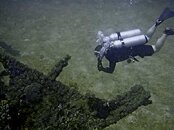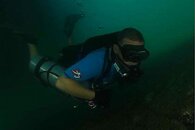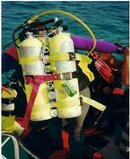I use 'cut-off' valves on the reg's w/my doubles..[yea,yea, I know and don't want to hear it]....With a manifold, if one of my reg's malfunctions, I close it off and still have all the air from both tanks...With no manifold and lose of a reg you loose 1/2 your air......
You are using an out of date browser. It may not display this or other websites correctly.
You should upgrade or use an alternative browser.
You should upgrade or use an alternative browser.
Doubles without a manifold
- Thread starter ajtoady
- Start date
Please register or login
Welcome to ScubaBoard, the world's largest scuba diving community. Registration is not required to read the forums, but we encourage you to join. Joining has its benefits and enables you to participate in the discussions.
Benefits of registering include
- Ability to post and comment on topics and discussions.
- A Free photo gallery to share your dive photos with the world.
- You can make this box go away
AfterDark
Contributor
I've been diving ID's for a very long time. I use two 50's, 72's or 90's LP depending on the dive. My arms can't reach the valves on manifolds because of the injuries and ops on my shoulders. So for me it's a good fit. If I lose half my air the dive over and up I go. I never have less than 1000 psi in either tank until after the dive is done. Another PRO is you don't need a hand truck to transport your "doubles". I've never encountered a trim issue even with a 2000psi difference between tanks. Just lucky I guess? Try it you'll like.
DevonDiver
N/A
Shouldn't that be a pro ? Because most if not all people I know that tried (apart from the individual know-it-all) went and got doubles with manifolds in the end...
So, by your definition, anyone who dives indie doubles is a "individual know-it-all"?
I dive both - indies and manifold. I used to use indie doubles for travelling...around 900 dives with them I'd guess (slightly more with manifolded)... a nice Custom Divers backplate that accepted cam-bands for doubles, it was great. Gave me access to technical dives in remote areas where manifolded doubles couldn't be rented. Probably not a consideration for the kool-aid flush sophisticates of Florida... but you just try jumping on buses and ferries in the Philippines and travelling for a few days to hit some remote island diving. Rarely used in the last few years because I sidemount now.
I must be an "individual know-it-all", albeit one that gets to dive in places unknown and unexplored by the "manifold dogma" crowd
For recreational dives, with adequate gas management, shut-downs shouldn't be critical on either manifolded or indie doubles. Nice if you can... but you'll be heading up anyway... and with plenty of gas to do so.

No manifold..."unacceptable"

No manifold..."acceptable"
This gets discussed (argued) from time to time.
In the mid 70's the discussion in the cave community was about single outlet doubles, versus independent doubles (two separate tanks, two separate regs) versus pigtails, versus dual outlet non isolated manifolds, versus the Benjamin conversion and the "ideal manifold" that eventually became the current idolator manifold. At the time, independent doubles were rated quite highly for the full redundancy they offered. You'll hear that same argument today from the side mount crowd, but in the two or so decades between the adoption of the isolator manifold as the standard and the the wide acceptance of side mount, independent doubles were vilified, mostly on the grounds that they offered no advantage over isolator manifolded doubles (which was not really true) and a couple downsides compared to them (which is true in some situations.
Personally, I used independent doubles and travel bands for travel tech diving, and in some very cold under ice applications. I now dive side mount almost exclusively and and thus I am again diving what amounts to the same redundant tank configuration.
Gas management is not hard, but is often over thought and over complicated by many side mount divers. In both theory and practice, outside of a very few exceptional situations (that can probably be better addressed through revision of configuration or improvement in trim) a diver only needs 2 reg switches per dive to ensure balanced gas use.
I've went into the math in depth in other posts, to demonstrate how to ensure you have gas at the turn in both tanks sufficient to get you out in the event you lose all the gas in either tank. But the short version is start on the left tank, breathe one "third" from it, then switch to the right tank, breath one "third" from it. (at this point you've used two of your six total "thirds", and have two of the four remaining "thirds" in each tank, so the loss of either tank still leaves you with gas "at least equal" to the gas you used to get to the max penetration point.) At this point ,you turn the dive, but continue on the right tank until a second "third" has been breathed. Then make the second reg switch to go back to the left tank and complete the dive. At the end of the dive you'll have 1/3 left in each tank - 1/2 of the total reserve for the dive in each tank.
Now the quotes around "third" and "at least equal" are pertinent as you can adjust the thirds as needed to increase the reserve. For example I may have 3600 psi in each tank and thus have 1200 psi "thirds". But if I decide to dive 1000 psi thirds instead (reducing the turn pressure by 200 psi per side), I will use only 1000 psi from each tank in the penetration and another 1000 psi from each tank on exit, leaving 1600 psi in each tank as a reserve rather than 1200 psi in each tank. It becomes a very easy way to increase the reserve to meet the increased demands of the dive (siphons, scooter dive, etc.).
Some side mount divers will advocate for 600 psi switches or even 300 psi switches, and in some cases they cite trim issues, but often it's just a non critical thinking way to achieve the same outcome as by keeping the tanks closer balances, they leave the option to turn the dive earlier to achieve the same thing you'd achieve with switching at "thirds", but it creates more work and creates a bigger hole in planning as it is amore ad hoc approach. (I'll go put my nomex suit on now).
One advantage of the thirds approach is that I know my gas consumption pretty well and I generally check the SPG about half way to the turn to confirm use rates, then usually confirm it when I switch, rarely being more than 50-100 psi from the planned turn pressure. Same with the exit. I think it's a plus and has advantages over excessive checking and switching of regs.
In the mid 70's the discussion in the cave community was about single outlet doubles, versus independent doubles (two separate tanks, two separate regs) versus pigtails, versus dual outlet non isolated manifolds, versus the Benjamin conversion and the "ideal manifold" that eventually became the current idolator manifold. At the time, independent doubles were rated quite highly for the full redundancy they offered. You'll hear that same argument today from the side mount crowd, but in the two or so decades between the adoption of the isolator manifold as the standard and the the wide acceptance of side mount, independent doubles were vilified, mostly on the grounds that they offered no advantage over isolator manifolded doubles (which was not really true) and a couple downsides compared to them (which is true in some situations.
Personally, I used independent doubles and travel bands for travel tech diving, and in some very cold under ice applications. I now dive side mount almost exclusively and and thus I am again diving what amounts to the same redundant tank configuration.
Gas management is not hard, but is often over thought and over complicated by many side mount divers. In both theory and practice, outside of a very few exceptional situations (that can probably be better addressed through revision of configuration or improvement in trim) a diver only needs 2 reg switches per dive to ensure balanced gas use.
I've went into the math in depth in other posts, to demonstrate how to ensure you have gas at the turn in both tanks sufficient to get you out in the event you lose all the gas in either tank. But the short version is start on the left tank, breathe one "third" from it, then switch to the right tank, breath one "third" from it. (at this point you've used two of your six total "thirds", and have two of the four remaining "thirds" in each tank, so the loss of either tank still leaves you with gas "at least equal" to the gas you used to get to the max penetration point.) At this point ,you turn the dive, but continue on the right tank until a second "third" has been breathed. Then make the second reg switch to go back to the left tank and complete the dive. At the end of the dive you'll have 1/3 left in each tank - 1/2 of the total reserve for the dive in each tank.
Now the quotes around "third" and "at least equal" are pertinent as you can adjust the thirds as needed to increase the reserve. For example I may have 3600 psi in each tank and thus have 1200 psi "thirds". But if I decide to dive 1000 psi thirds instead (reducing the turn pressure by 200 psi per side), I will use only 1000 psi from each tank in the penetration and another 1000 psi from each tank on exit, leaving 1600 psi in each tank as a reserve rather than 1200 psi in each tank. It becomes a very easy way to increase the reserve to meet the increased demands of the dive (siphons, scooter dive, etc.).
Some side mount divers will advocate for 600 psi switches or even 300 psi switches, and in some cases they cite trim issues, but often it's just a non critical thinking way to achieve the same outcome as by keeping the tanks closer balances, they leave the option to turn the dive earlier to achieve the same thing you'd achieve with switching at "thirds", but it creates more work and creates a bigger hole in planning as it is amore ad hoc approach. (I'll go put my nomex suit on now).
One advantage of the thirds approach is that I know my gas consumption pretty well and I generally check the SPG about half way to the turn to confirm use rates, then usually confirm it when I switch, rarely being more than 50-100 psi from the planned turn pressure. Same with the exit. I think it's a plus and has advantages over excessive checking and switching of regs.
Out of curiosity, how do you manage trim when one side gets lighter than the other?
You swap regs and breath from the other tank. Usually divers are taught to breath 500psi at a time before swapping tanks/regs.
skankpile
Contributor
- Messages
- 403
- Reaction score
- 75
- Location
- Sugarland, TX (SW Houston)
- # of dives
- I just don't log dives
Just do it, but put them on your side and call it side-mount. You will be the envy of all your friends, and flowers will bloom in your footsteps.
You will be able to see any leaks and easily access the valves, regs, and carry around your tanks easily... it just makes sense.
You will be able to see any leaks and easily access the valves, regs, and carry around your tanks easily... it just makes sense.
Which is what irritates me. It's learning by rote with no consideration of why that arbitrary number may or may not be appropriate.You swap regs and breath from the other tank. Usually divers are taught to breath 500psi at a time before swapping tanks/regs.
The only basis is often something like "500 psi ensures the differential between tanks is not enough to affect trim." However, even then to maintain a min/max differential you'd use 500 psi from one tank then use 1000 psi from the other. To first even out the maximum 500 psi differential to zero, then increase it again by 500 psi before another switch is even needed. Practically it's the difference between "light on the left to neutral, then light on the left again", versus, "light on the left, neutral, light on the right back to neutral". The latter works better and has have as many reg switches.
That's just the trim issue. I won't even get into proper gas planning, ad maintaining balanced reserves between tanks, or the lack there of with the 500 psi and switch approach per tank...
- Messages
- 93,950
- Reaction score
- 92,746
- Location
- On the Fun Side of Trump's Wall
- # of dives
- 2500 - 4999
Will attract scorn from DIR-types
I'm assuming that's intended as humor. I've been diving sidemount for about 14 months now, and not one DIR person has scorned me, despite the fact that I dive with DIR-trained divers rather regularly.
They don't bother me about my solo diving either.
Then again, I tend to avoid scorny people, however they were trained or choose to dive ...
... Bob (Grateful Diver)
DevonDiver
N/A
I'm assuming that's intended as humor.
Naturally... tongue-in-cheek.
Similar threads
- Replies
- 20
- Views
- 2,120
- Replies
- 4
- Views
- 773
- Replies
- 9
- Views
- 920





